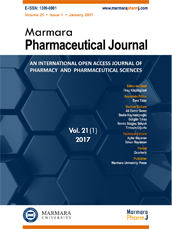Editor-in-Chief
Hatice Kübra Elçioğlu
Vice Editors
Levent Kabasakal
Esra Tatar
Online ISSN
2630-6344
Publisher
Marmara University
Frequency
Bimonthly (Six issues / year)
Abbreviation
J.Res.Pharm.
Former Name
Marmara Pharmaceutical Journal
Marmara Pharmaceutical Journal
2017 , Vol 21 , Issue 3
Phytochemical analysis of some plants from Lamiaceae family frequently used in folk medicine in Aligudarz region of Lorestan province
1Department of Pharmacognosy, School of Pharmacy, Isfahan University of Medical Sciences, Isfahan, Iran2Student Research Committee, Shahrekord University of Medical Sciences, Shahrekord, Iran DOI : 10.12991/marupj.311815 Many of the plants from the Lamiaceae family have been traditionally used as medicine all over the world. Also, some of the secondary metabolites isolated from this family have shown interesting biological function. In this study we have analyzed phytochemicals of some plants from Lamiaceae family frequently used in folk medicine in Aligudarz region of Lorestan province. In this regard, the plant species were collected and systematically identified during 2014-2015. The traditional and local uses of collected plants were questioned through informed consent semi-structured interviews with local informants. Phytochemical analysis was conducted to test the presence of compounds such as alkaloids, flavonoids, saponins, tannins, anthraquinone and glycosides. 25 plant species belonging to 13 genes were collected and identified. The most uses of the plants were in treating cold, gastrointestinal disorders and as flavoring agents. From 25 plant species, a number of 23 species had tannin, 22 species exhibited positive reactions to flavonoids, 4 species showed positive reactions to alkaloids and 1 species exhibited positive reactions to saponins. This research has provided insights on the use of secondary metabolites in folk medicine for promotion of appropriate human health. The studied plants in this article can be seen as a potential source for discovering new drugs. Keywords : Medicinal plants, Lamiaceae, Ethnobotany, Pharmacognosy

